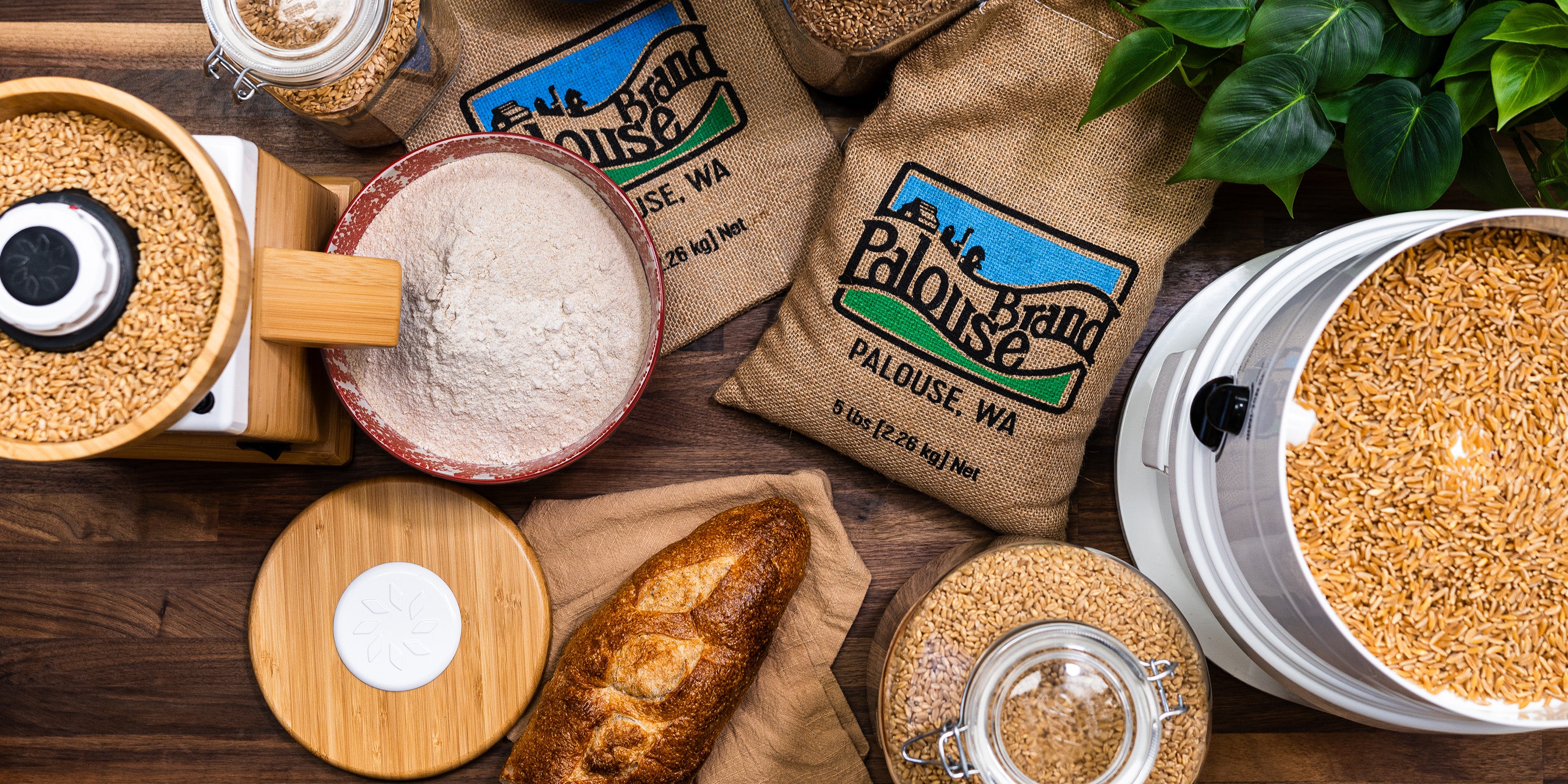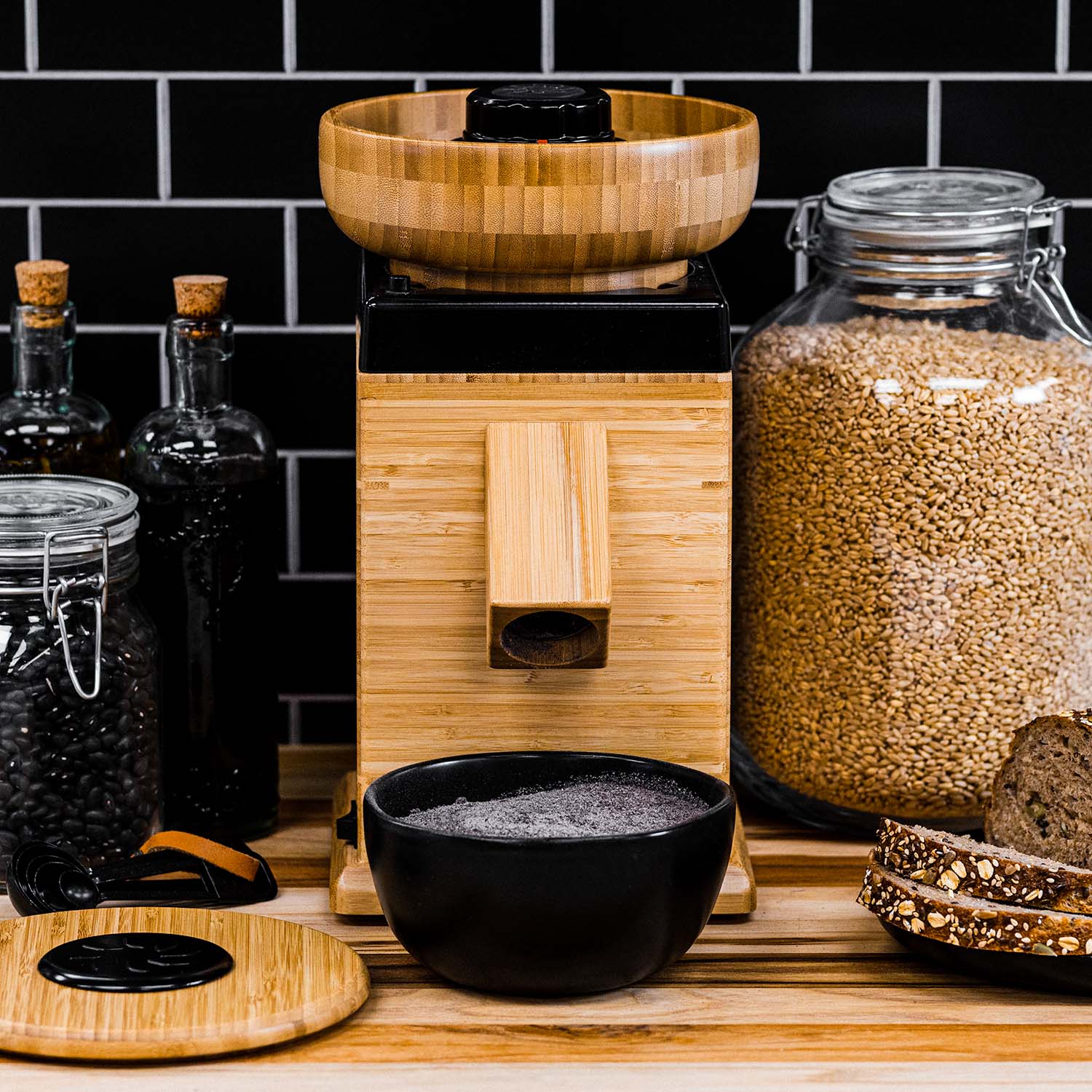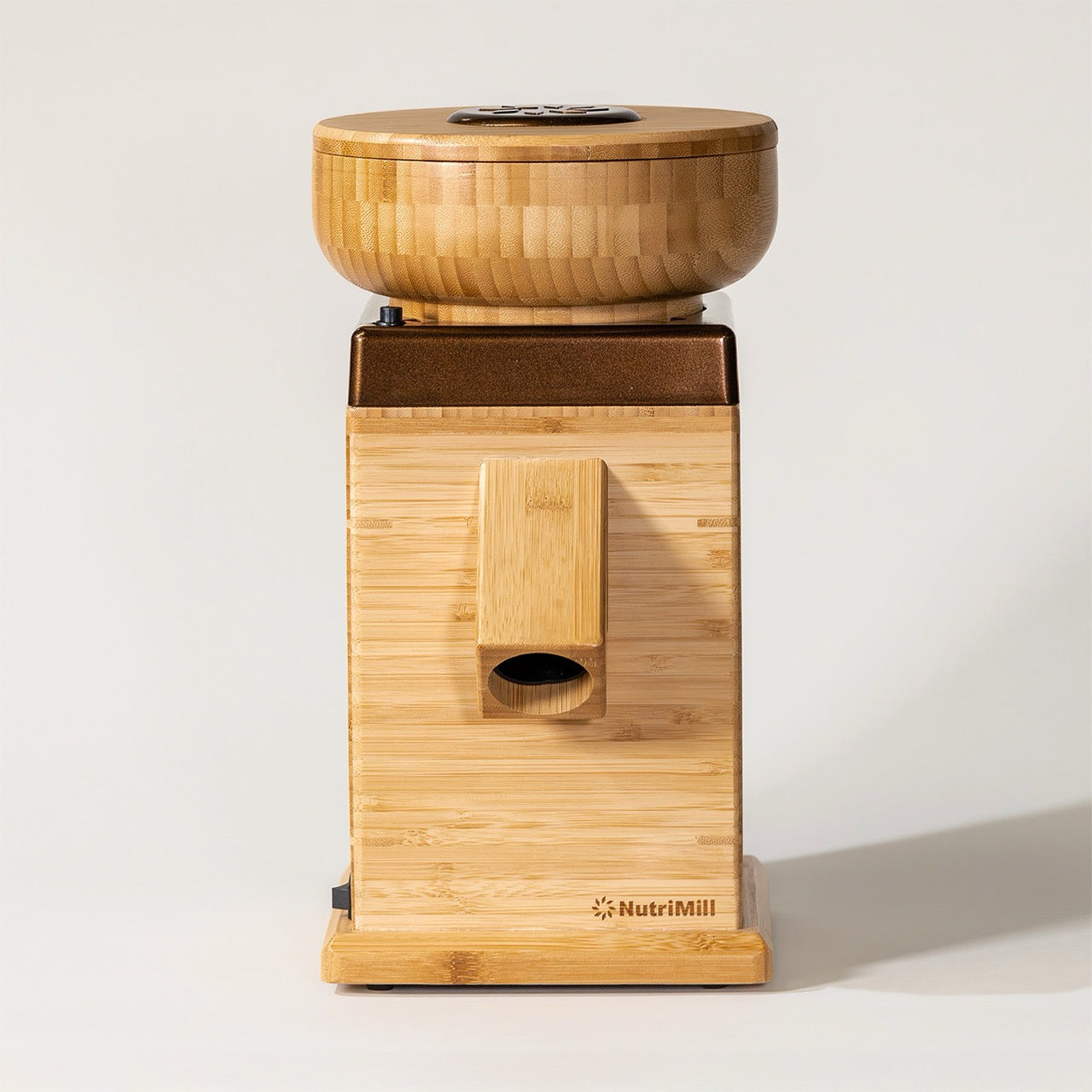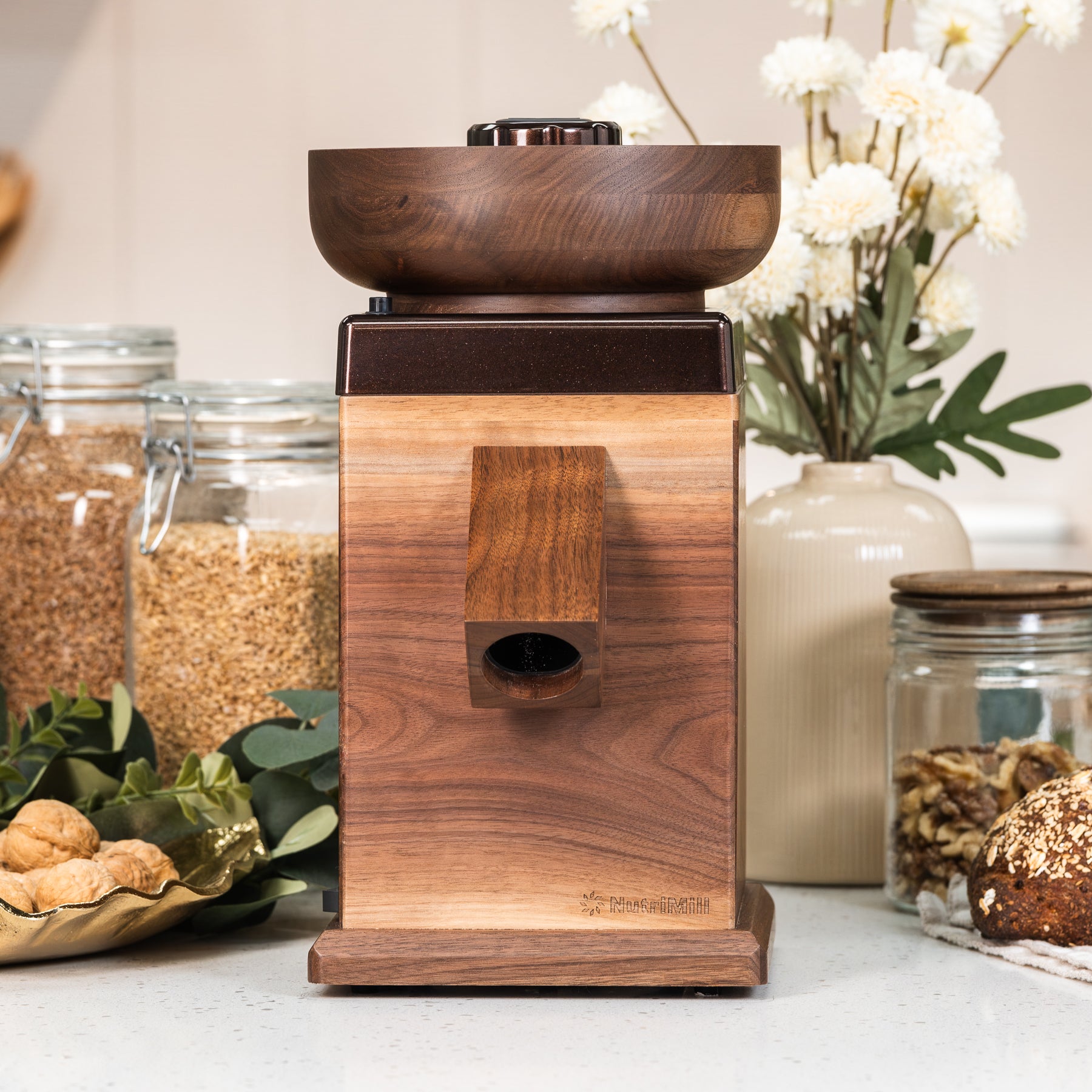Compare Grain Mills






Bread Flour
Large Batches
Versatility
High Speed Impact
High Speed Impact
Stone Grind
Stainless Steel
Stainless Steel
Corundum Stone
Fine - Coarse
Fine - Coarse
Fine - Cracked
8 Cups
12 Cups
5 Cups
12 Cups
20 Cups
Continuous
~118°F average
~118°F average
100–115°F, varies with texture.
Small - Medium
Small - Large
Small - Extra Large
78-98 db
78-98 db
71-92 db
15.5"L x 8.25W" x 9"H
13.5"L x 11.5"W x 12"H
15.5"L x 8.25W" x 13"H
13.5"L x 11.5"W x 14.5"H
9"L x 6"W x 13"H
1200-watt motor
1200-watt motor
450-watt motor
Limited Life Time
Limited Life Time
5 - Year
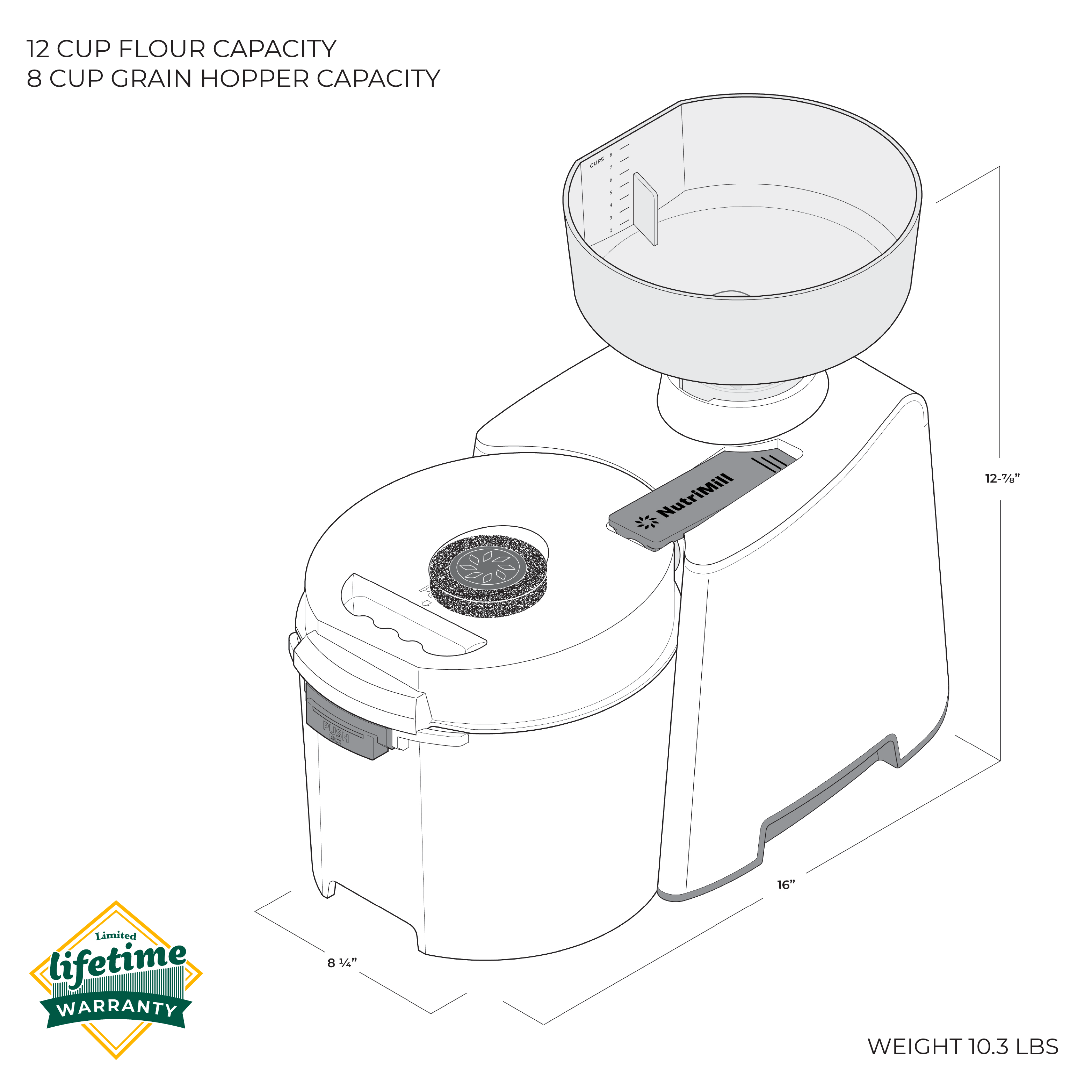
Impact
High Speed Grain Mill

Classic
High Speed Grain Mill

Harvest
Stone Grain Mill
Mill any non-oily grains or legumes
Mill Any of the Following
Whole Grains
Kamut - Nutrient-rich ancient wheat grain, milled for its protein, fiber, vitamins, and minerals.
Spelt - Ancient grain with a sweet, nutty flavor, milled for its fiber, protein, vitamins, and minerals.
Barley - Versatile grain with nutty flavor, milled for fiber, vitamins, minerals, and heart health benefits.
Farro - Chewy, nutty ancient wheat grain, milled for high protein, fiber, vitamins, and minerals.
Rye - Hearty grain with sour flavor, milled for fiber, vitamins, minerals, and blood sugar control.
Soft Wheat - Mild-flavored wheat for baking cakes, pastries, and some bread.
Hard Wheat - High-protein wheat for bread and pasta, milled for gluten structure.
Triticale - Hybrid grain for protein, fiber, vitamins, minerals, and culinary versatility.
Emmer - Ancient grain with nutty flavor, milled for protein, fiber, vitamins, and minerals.
Einkorn - Oldest cultivated wheat, rich in flavor and nutrients, milled for protein, fiber, vitamins, and minerals.
Bulgur Wheat - Its high fiber content, rich nutrients, and whole grain benefits, offering versatile culinary applications and promoting satiety and weight management.
For any grains not listed above, mill only ¼ cup, then test the flour by pinching a small amount between your thumb and finger. If it holds the shape of a pinch and does not fall apart, it contains too much moisture. Do not mill this grain.
Gluten-Free Grains
Dried Sweet Corn - Milling sweet corn produces cornmeal, ideal for baking sweet treats like cornbread and muffins.
Oat Groats - Rich in fiber and nutrients, perfect for hearty baked goods such as bread and cookies.
White Rice - Commonly used in gluten-free baking to achieve light and delicate textures in pastries and cakes.
Brown Rice - Retains its nutritional value, offering a fiber-rich alternative for baking bread and thickening sauces.
Teff - Gluten-free and nutrient-dense, making it a suitable choice for baking bread, muffins, and cookies.
Sorghum - Packed with antioxidants and minerals, enhancing the nutritional profile of gluten-free baked goods like bread and cakes.
Millet - Mild-flavored flour, perfect for gluten-free baking, adding a slightly sweet taste and light texture to bread and cookies.
Buckwheat - Nutrient-rich and gluten-free, ideal for making pancakes, noodles, and bread with a distinctive earthy flavor.
Quinoa - Gluten-free and high in protein, making it a nutritious choice for baking bread, muffins, and cookies.
Amaranth - Dense and nutty, adding a unique flavor and texture to baked goods like bread and cookies while providing essential nutrients.
Kaniwa - Similar to quinoa, is a nutrient-rich pseudo-grain packed with protein, fiber, and essential minerals such as iron and calcium.
For any grains not listed above, mill only ¼ cup, then test the flour by pinching a small amount between your thumb and finger. If it holds the shape of a pinch and does not fall apart, it contains too much moisture. Do not mill this grain.
Gluten-Free Legumes
Lentils - Protein-rich and fiber-packed ingredient ideal for gluten-free baking, adding nutritional value to bread, pancakes, and other baked goods.
Chickpeas - Versatile gluten-free option packed with protein and fiber, commonly used in baking for bread, cakes, and savory dishes like falafel.
Baby Lima Beans - Rich in protein and fiber, suitable for gluten-free baking, contributing a delicate texture and buttery flavor to bread and cookies.
Mung Beans - Gluten-free and protein-rich, perfect for baking bread, pancakes, and desserts, adding a slightly sweet and nutty taste.
Black Beans - Gluten-free option packed with protein, fiber, and essential nutrients, ideal for baking bread, brownies, and other treats with a rich, earthy flavor.
Navy Beans - High in protein and fiber, suitable for gluten-free baking, adding moisture and a creamy texture to bread, muffins, and cookies.
Split Peas - Rich in protein and fiber, commonly used in baking for bread, pancakes, and savory dishes like split pea soup, imparting a hearty flavor and texture.
Pinto Beans - Nutritious gluten-free option rich in protein and fiber, ideal for baking bread, tortillas, and other treats with a slightly sweet and nutty taste.
Soybeans - Protein-packed option suitable for gluten-free baking, used in bread, cookies, and other baked goods, providing a rich and nutty flavor.
Anasazi Beans - Vibrant color and creamy texture, offer a nutritious source of protein, fiber, and various vitamins and minerals, contributing to a balanced diet and culinary diversity.
Kidney Beans - Nutrient-rich source of protein, fiber, iron, and potassium, supporting heart health and digestion.
For any grains not listed above, mill only ¼ cup, then test the flour by pinching a small amount between your thumb and finger. If it holds the shape of a pinch and does not fall apart, it contains too much moisture. Do not mill this grain.
Kamut - Nutrient-rich ancient wheat grain, milled for its protein, fiber, vitamins, and minerals.
Spelt - Ancient grain with a sweet, nutty flavor, milled for its fiber, protein, vitamins, and minerals.
Barley - Versatile grain with nutty flavor, milled for fiber, vitamins, minerals, and heart health benefits.
Farro - Chewy, nutty ancient wheat grain, milled for high protein, fiber, vitamins, and minerals.
Rye - Hearty grain with sour flavor, milled for fiber, vitamins, minerals, and blood sugar control.
Soft Wheat - Mild-flavored wheat for baking cakes, pastries, and some bread.
Hard Wheat - High-protein wheat for bread and pasta, milled for gluten structure.
Triticale - Hybrid grain for protein, fiber, vitamins, minerals, and culinary versatility.
Emmer - Ancient grain with nutty flavor, milled for protein, fiber, vitamins, and minerals.
Einkorn - Oldest cultivated wheat, rich in flavor and nutrients, milled for protein, fiber, vitamins, and minerals.
Bulgur Wheat - Its high fiber content, rich nutrients, and whole grain benefits, offering versatile culinary applications and promoting satiety and weight management.
For any grains not listed above, mill only ¼ cup, then test the flour by pinching a small amount between your thumb and finger. If it holds the shape of a pinch and does not fall apart, it contains too much moisture. Do not mill this grain.
Dried Sweet Corn - Milling sweet corn produces cornmeal, ideal for baking sweet treats like cornbread and muffins.
Oat Groats - Rich in fiber and nutrients, perfect for hearty baked goods such as bread and cookies.
White Rice - Commonly used in gluten-free baking to achieve light and delicate textures in pastries and cakes.
Brown Rice - Retains its nutritional value, offering a fiber-rich alternative for baking bread and thickening sauces.
Teff - Gluten-free and nutrient-dense, making it a suitable choice for baking bread, muffins, and cookies.
Sorghum - Packed with antioxidants and minerals, enhancing the nutritional profile of gluten-free baked goods like bread and cakes.
Millet - Mild-flavored flour, perfect for gluten-free baking, adding a slightly sweet taste and light texture to bread and cookies.
Buckwheat - Nutrient-rich and gluten-free, ideal for making pancakes, noodles, and bread with a distinctive earthy flavor.
Quinoa - Gluten-free and high in protein, making it a nutritious choice for baking bread, muffins, and cookies.
Amaranth - Dense and nutty, adding a unique flavor and texture to baked goods like bread and cookies while providing essential nutrients.
Kaniwa - Similar to quinoa, is a nutrient-rich pseudo-grain packed with protein, fiber, and essential minerals such as iron and calcium.
For any grains not listed above, mill only ¼ cup, then test the flour by pinching a small amount between your thumb and finger. If it holds the shape of a pinch and does not fall apart, it contains too much moisture. Do not mill this grain.
Lentils - Protein-rich and fiber-packed ingredient ideal for gluten-free baking, adding nutritional value to bread, pancakes, and other baked goods.
Chickpeas - Versatile gluten-free option packed with protein and fiber, commonly used in baking for bread, cakes, and savory dishes like falafel.
Baby Lima Beans - Rich in protein and fiber, suitable for gluten-free baking, contributing a delicate texture and buttery flavor to bread and cookies.
Mung Beans - Gluten-free and protein-rich, perfect for baking bread, pancakes, and desserts, adding a slightly sweet and nutty taste.
Black Beans - Gluten-free option packed with protein, fiber, and essential nutrients, ideal for baking bread, brownies, and other treats with a rich, earthy flavor.
Navy Beans - High in protein and fiber, suitable for gluten-free baking, adding moisture and a creamy texture to bread, muffins, and cookies.
Split Peas - Rich in protein and fiber, commonly used in baking for bread, pancakes, and savory dishes like split pea soup, imparting a hearty flavor and texture.
Pinto Beans - Nutritious gluten-free option rich in protein and fiber, ideal for baking bread, tortillas, and other treats with a slightly sweet and nutty taste.
Soybeans - Protein-packed option suitable for gluten-free baking, used in bread, cookies, and other baked goods, providing a rich and nutty flavor.
Anasazi Beans - Vibrant color and creamy texture, offer a nutritious source of protein, fiber, and various vitamins and minerals, contributing to a balanced diet and culinary diversity.
Kidney Beans - Nutrient-rich source of protein, fiber, iron, and potassium, supporting heart health and digestion.
For any grains not listed above, mill only ¼ cup, then test the flour by pinching a small amount between your thumb and finger. If it holds the shape of a pinch and does not fall apart, it contains too much moisture. Do not mill this grain.
The Fresher the Flour, the Fresher the Food.
Helpful Tips for Freshly Milled Flour
Converting Measurements
Converting recipes from refined white flour to whole grain flour is often a matter of trial and error. Many factors, such as the type of recipe, your climate, and your choice of texture when grinding, all play a part in the final results. Keep notes on how much flour you use and whether more or less is needed next time. It may take a few attempts before you find just the right amount to suit your taste.
Hard vs. Soft Wheat
Soft wheat flour, also known as whole wheat pastry flour, has less protein and creates a lighter textured product than hard wheat. Soft wheat does not work as well for yeast breads, but it is excellent for cakes, cookies, muffins, etc. Soft wheat is closer to all-purpose flour and need not be adjusted as much as hard wheat flour when converting recipes. Hard wheat flour is higher in protein than soft wheat flour. Hard wheat can be used for every type of recipe, but is essential for yeast breads.
Slowly Integrate into Diet
Add whole grains to your diet gradually, to help your family's taste buds and digestive systems adjust. Start by replacing 25% (or less) of the white flour in your favorite recipes with whole grain flour. Gradually increase to 50% whole grain flour, and so on. Most recipes work well without adjustments until you begin substituting more than 50% whole grain flour.
Storing
After milling grains & legumes, refrigerate or freeze any leftover flour to preserve as many nutrients as possible. Flour may be stored up to 2 weeks in the refrigerator or up to 3-6 months in the freezer.
Mixing Grains
Grains may be mixed and milled together at the same time. Choose grains of similar size for best results. Try a variety of flour mixtures to add variety, flavor, and texture to your recipes.
Adjust Flavor
Increase the amount of herbs and spices in your recipe by up to 50%. White flour is neutral and has no flavor, but whole grain and bean flours can mask the taste of other ingredients.
Conversion
For each cup of white flour in a recipe, replace with 3/4 to 7/8 cup of hard whole wheat flour or 7/8 to 1 cup of soft wheat flour. Whole grain flours absorb more liquid than all-purpose flour, so instead of using less flour, you may increase the liquid called for in the recipe.
Need Extra Protein?
Bean flours provide extra protein and may be added in small quantities to any baked goods. You can replace up to 10%-25% of the wheat flour in your recipes with almost any bean, pea or lentil flour.
Autolyse
Mix flour and water in bread making, let it rest before adding other ingredients. Improves gluten development for easier handling, enhances flavor and texture. Simple yet effective technique for homemade bread.
We love this mill [Harvest]! Its easy and fast and a true stone grind. We have been making bread for everyone we love!
The NutriMill [Harvest] works great and is so easy to use. My kids love using it, and baking with fresh flour is a game changer!
I absolutely love it [Classic]! It is about as loud as a vacuum, grinds fast, And is easy to clean. I highly recommend if.
Fine fluffy flour, does [Classic] the job very well.
FAQ
Frequently Asked Questions
What are grain mills used for?
Grain mills are for grinding grains into flour or meal, ideal for baking, cooking, or other culinary needs.
Why should I mill my own grains?
Milling your own grains offers fresher flour with enhanced flavor and nutritional value versus store-bought options. It grants control over the grind texture and guarantees no additives or preservatives.
What is the difference between stone and high speed in grain mills?
Stone Milling heads are commonly found in traditional grain mills, and provide a natural texture.
High speed grain mills use stainless steel milling heads that quickly pulverize grains into flour. This process is not only fast but also prevents excessive heat build up.
How long does it take to mill grains with a grain mill?
The milling time varies based on type of mill, grain type, feed rate, and motor speed. Finer flour takes more time to mill. Compared to coarse flour that flows through the mill more quickly.
How do I store freshly milled flour?
Freshly ground flour must be stored in an airtight container in a cool, dry area to preserve its freshness and avoid spoilage. Some individuals opt to keep flour in the refrigerator or freezer for extended shelf life.
Can I use a grain mill to make gluten-free flour?
Grain mills can grind gluten-free grains like rice, quinoa, and millet for flour. Once a mill has been used with gluten grains, then the flour from that grain mill cannot be considered 100% gluten free. (We offer replacement stones if switching to gluten free.)

Freshly Milled Flour: A Game-Changer in Home Baking
Welcome to the world of home baking, where the secret to that perfect loaf of bread or that mouth-watering pastry might just lie in a simple yet revolutionary ingredient: freshly milled flour. For...








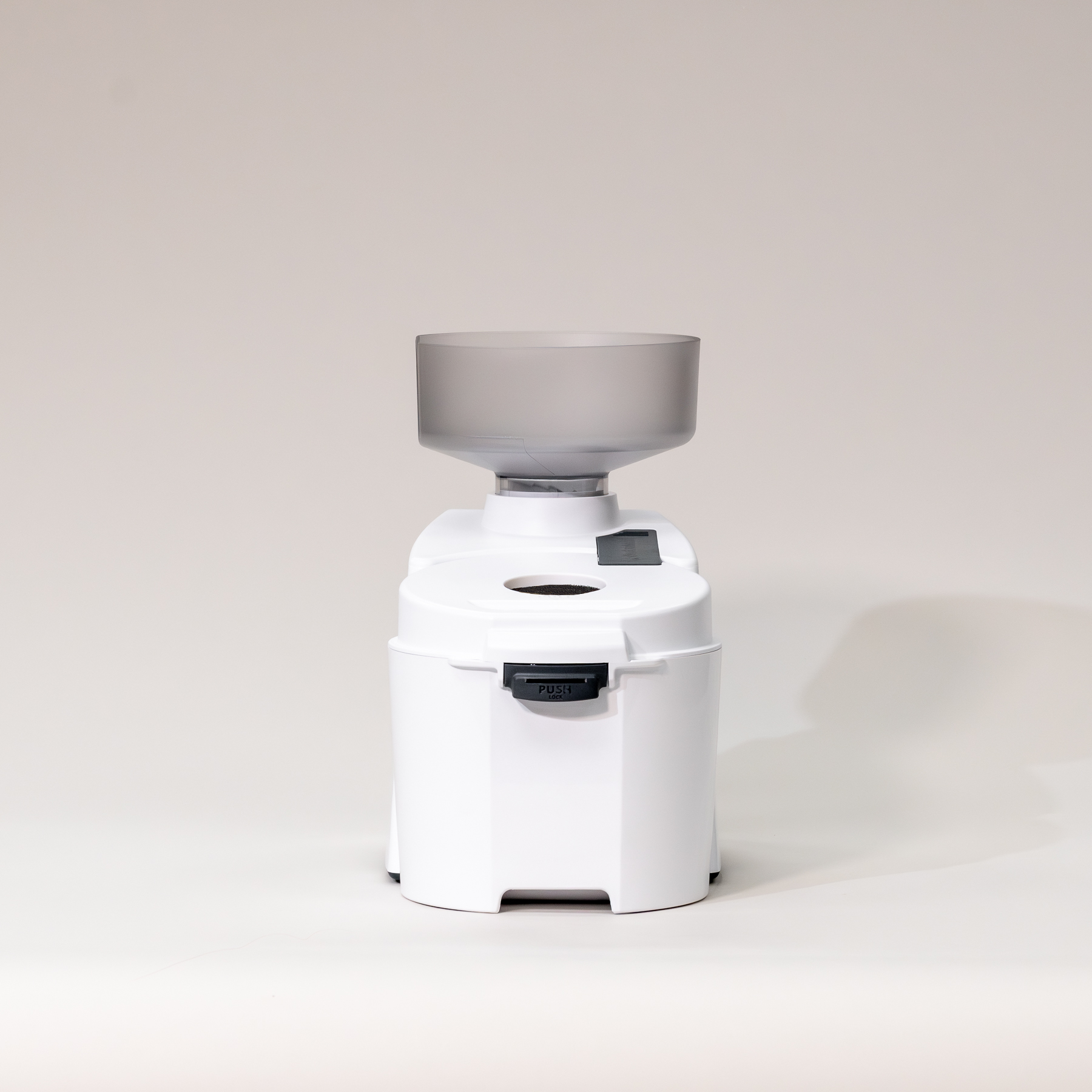



The Ultimate Bread Flour Mill
For passionate bread bakers, the NutriMill Impact Grain Mill offers the perfect blend of performance, size, and affordability. Designed with advanced impact milling technology, it guarantees the precise consistency and quality needed for your favorite loaves, ensuring every bake is a success.
Why Impact Milling
Impact milling delivers consistent, high-quality flour, which is essential for achieving the perfect loaf. The NutriMill Impact Grain Mill is specifically engineered to produce flour with the ideal texture and properties for bread-making, ensuring dough that rises beautifully and bread that is soft, flavorful, and perfectly textured.
Engineered for Bread Flour Excellence
Whether you're milling hard wheat for robust whole grain bread or soft wheat for sandwich loaves, the NutriMill Impact Grain Mill ensures precise and consistent results. It’s compact, affordable, and perfect for entry-level millers and bakers who want to elevate their bread-making without breaking the bank.
Compact & Affordable
Smaller in size, yet powerful in performance, this grain mill is the ideal choice for those just starting out in milling or bread baking. Its entry-level price point makes it accessible for any home baker looking to create fresh, high-quality flour without sacrificing space or budget.

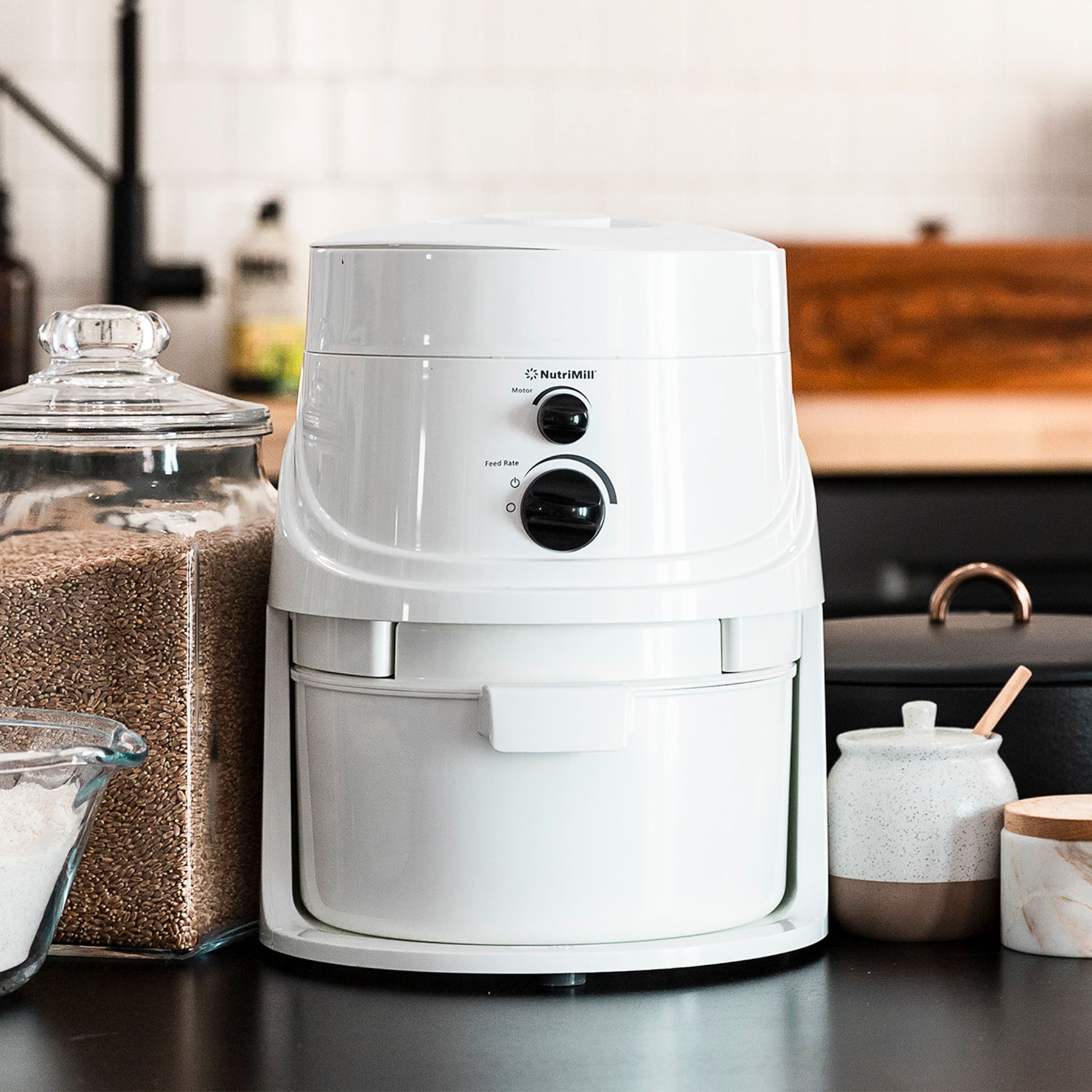








Homemade Matters®
The Most Trusted High-Speed Grain Mill for 20+ Years
The NutriMill Classic has been its #1 selling mill for over 20 years, used and loved by home bakers for over two decades. With powerful milling performance, intuitive controls, and thoughtful upgrades that set it apart from older impact mill designs, the Classic delivers fresh flour fast, cleanly, and reliably.
Fresh Flour, Your Way Every Day
Whether you’re grinding wheat for homemade bread or preparing fresh flour for gluten-free baking, the Classic makes it easy to mill a wide variety of non-oily grains, beans, and legumes with speed and precision. Its variable texture controls allow you to fine-tune your flour from fine to coarser grinds using the dial controls designed specifically for high-speed impact milling.
Powerful
A 10-amp, 1¾ horsepower motor powers the Classic’s high-speed impact chamber (micronizer), using stainless steel milling heads to grind up to 20 cups of flour at a time. Its newly improved airflow design also keeps flour temperatures around 118°F, protecting nutrients during milling and making it the coolest-running impact mill in the world.
Adjustable
The NutriMill Classic gives you complete control over your flour texture. With a 400% adjustment range, you can grind super fine (finer than any other impact mill) or coarser textures ideal for rustic bakes. That’s 10 times more texture range than earlier impact mills, perfect for everything from soft sandwich loaves to hearty cornbread.
Convenient
- Grain first, power second – Thanks to its redesigned impact chamber, you can safely fill the hopper before turning the mill on without clogging.
- Auto-restart functionality – The Classic restarts effortlessly without jamming if you pause grinding.
- Self-cleaning milling heads – The internal chamber cleans itself as you grind.
- Dust-free design – Milling is clean and contained with a perfectly paired flour bin and grain hopper.
- Compact and portable – Easy-grip handles and a single-body design make it simple to move and store.
Efficient by Design
Everything about the NutriMill Classic is optimized for frequent, mess-free home use from its smooth operation and high-capacity output to its modern airflow and clean-up features. Whether milling once a week or every day, fresh flour is part of your lifestyle without adding stress to your kitchen.
Product Resources
Videos, Guides, and More






